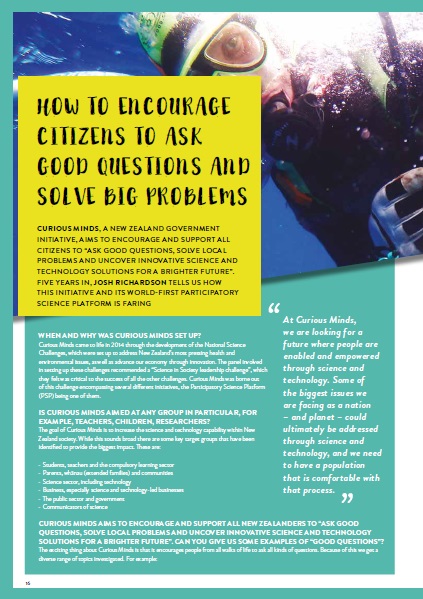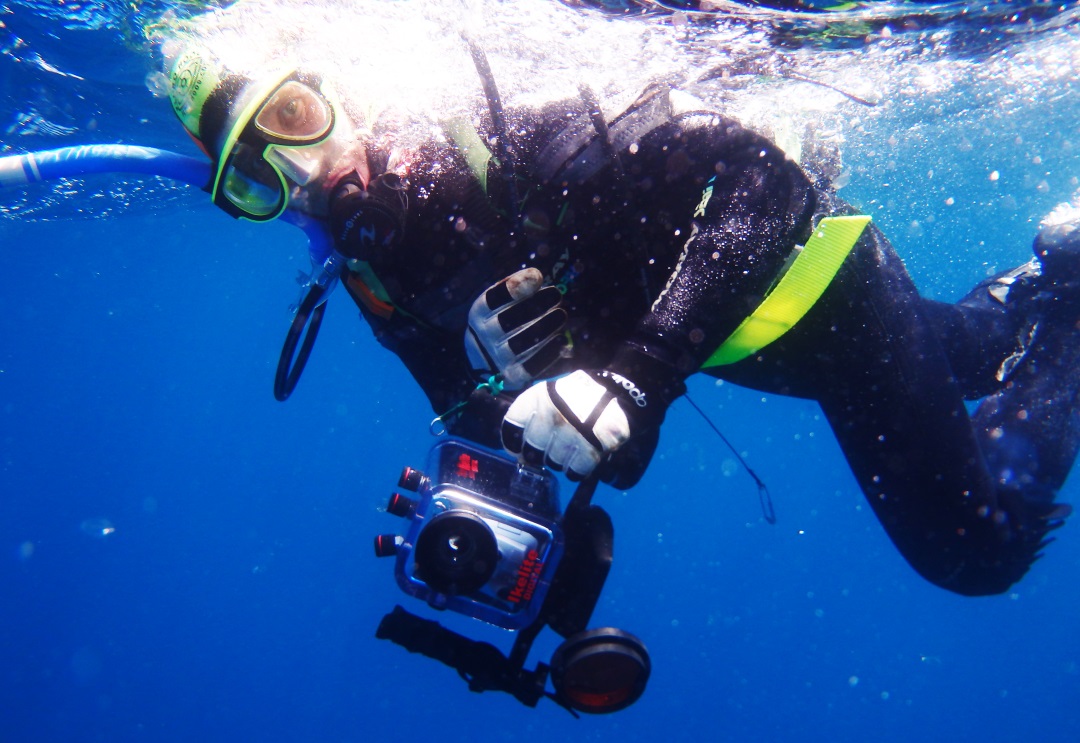How to encourage citizens to ask good questions and solve big problems
WHEN AND WHY WAS CURIOUS MINDS SET UP?
Curious Minds came to life in 2014 through the development of the National Science Challenges, which were set up to address New Zealand’s most pressing health and environmental issues, as well as advance our economy through innovation. The panel involved in setting up these challenges recommended a “Science in Society leadership challenge”, which they felt was critical to the success of all the other challenges. Curious Minds was borne out of this challenge encompassing several different initiatives, the Participatory Science Platform (PSP) being one of them.
IS CURIOUS MINDS AIMED AT ANY GROUP IN PARTICULAR, FOR EXAMPLE, TEACHERS, CHILDREN, RESEARCHERS?
The goal of Curious Minds is to increase the science and technology capability within New Zealand society. While this sounds broad there are some key target groups that have been identified to provide the biggest impact. These are:
- Students, teachers and the compulsory learning sector
- Parents, whānau (extended families) and communities
- Science sector, including technology
- Business, especially science and technology-led businesses
- The public sector and government
- Communicators of science
CURIOUS MINDS AIMS TO ENCOURAGE AND SUPPORT ALL NEW ZEALANDERS TO “ASK GOOD QUESTIONS, SOLVE LOCAL PROBLEMS AND UNCOVER INNOVATIVE SCIENCE AND TECHNOLOGY SOLUTIONS FOR A BRIGHTER FUTURE”. CAN YOU GIVE US SOME EXAMPLES OF “GOOD QUESTIONS”?
The exciting thing about Curious Minds is that it encourages people from all walks of life to ask all kinds of questions. Because of this we get a diverse range of topics investigated. For example:
- Ngāti Tawhirikura hapū (a Māori kinship group or tribe in Taranaki) worked with our local museum to investigate whether the Motunui Epa (200-year-old carved panels) were created with stone or wooden tools.
- Students from two New Plymouth High Schools worked with Massey University to ask questions around how interference is impacting the wireless connectivity of rural Taranaki.
- Woodleigh School students asked if they could create natural alternatives to repelling mosquitos in their outdoor classroom.
- Te Rūnanga o Ngāti Mutunga wanted to learn more about the distribution of frogs in North Taranaki and what this distribution indicated in terms of eco-system health.
Curious Minds came to life in 2014 through the development of the National Science Challenges, which were set up to address New Zealand’s most pressing health and environmental issues, as well as advance our economy through innovation. The panel involved in setting up these challenges recommended a “Science in Society leadership challenge”, which they felt was critical to the success of all the other challenges. Curious Minds was borne out of this challenge encompassing several different initiatives, the Participatory Science Platform (PSP) being one of them.
IS CURIOUS MINDS AIMED AT ANY GROUP IN PARTICULAR, FOR EXAMPLE, TEACHERS, CHILDREN, RESEARCHERS?
The goal of Curious Minds is to increase the science and technology capability within New Zealand society. While this sounds broad there are some key target groups that have been identified to provide the biggest impact. These are:
- Students, teachers and the compulsory learning sector
- Parents, whānau (extended families) and communities
- Science sector, including technology
- Business, especially science and technology-led businesses
- The public sector and government
- Communicators of science
CURIOUS MINDS AIMS TO ENCOURAGE AND SUPPORT ALL NEW ZEALANDERS TO “ASK GOOD QUESTIONS, SOLVE LOCAL PROBLEMS AND UNCOVER INNOVATIVE SCIENCE AND TECHNOLOGY SOLUTIONS FOR A BRIGHTER FUTURE”. CAN YOU GIVE US SOME EXAMPLES OF “GOOD QUESTIONS”?
The exciting thing about Curious Minds is that it encourages people from all walks of life to ask all kinds of questions. Because of this we get a diverse range of topics investigated. For example:
- Ngāti Tawhirikura hapū (a Māori kinship group or tribe in Taranaki) worked with our local museum to investigate whether the Motunui Epa (200-year-old carved panels) were created with stone or wooden tools.
- Students from two New Plymouth High Schools worked with Massey University to ask questions around how interference is impacting the wireless connectivity of rural Taranaki.
- Woodleigh School students asked if they could create natural alternatives to repelling mosquitos in their outdoor classroom.
- Te Rūnanga o Ngāti Mutunga wanted to learn more about the distribution of frogs in North Taranaki and what this distribution indicated in terms of eco-system health.
Many of our projects focus on local environmental issues and end up contributing really important information. We frequently see projects sharing results with other groups, as well as governing bodies and decision makers. A couple of examples include:
- Project Hotspot, which has worked with schools to collect information on coastal species that were at risk or threatened. Through this work they identified plastic shotgun wads washing up on beaches. Working with the community and Taranaki Fish and Game, the results from this project led gun clubs to establish policies around the use of biodegradable wads, drastically reducing the amount of plastic put into the environment through this sport.
- Project Reef Life has been working since 2015 to document and monitor marine biodiversity within the South Taranaki Bight. Because there is little information currently available in this area, their findings have been used to inform the Taranaki Regional Council’s Coastal Plan.
THE PSP BUILDS ON CITIZEN SCIENCE, ENCOURAGING PEOPLE FROM ALL WALKS OF LIFE TO ENGAGE IN LOCAL AND RELEVANT RESEARCH PROJECTS. DESCRIBED AS A “WORLD-FIRST INITIATIVE”, WHAT MAKES IT SO UNIQUE?
The PSP is a process for collaboration and shared learning. It is a marriage between community action and science where all partners are equally involved in every step of the journey. Participants are involved through each aspect of the scientific process, from generating questions and hypotheses, to method development, implementation, analysis and communication of results.
A PSP project requires more than community exposure to science, or participation in a certain element of the process, it requires full integration and co-creation. Because of this we see projects that are consistent with our “locally relevant” ethos. These projects support two-way learning opportunities where scientists are getting more than data from a community but a suite of cultural, contextual and environmental learnings.
HOW CAN SCHOOLS GET INVOLVED?
While the PSP is not designed to be exclusively run through schools, many of our projects partner with schools and other education groups. Since 2015 we have had 43 schools involved in PSP projects in Taranaki alone. Some schools decide to run projects themselves, but most tend to join a project run by an outside organisation. What we are observing is that, for many teachers, this opportunity to work on a PSP project allows them to grow their confidence in science, and often leads to schools continuing to increase their science programmes even after their involvement ends.
WHAT HAVE BEEN THE MOST NOTABLE BENEFITS OF THE PSP?
From my perspective the most notable benefits are:
- The PSP has created an avenue for collaboration between the science sector and the Taranaki community that goes beyond a crowdsourcing approach.
- Schools are being given greater opportunity to incorporate science learning into their programme through meaningful project work. This is also leading to increased teacher confidence in delivering science education.
- Relationship building between different organisations, age demographics, and cultural groups. One key example of this is students getting to work alongside scientists breaking down preconceived conceptions of what a scientist is or does. It also offers line of sight to a wider range of career opportunities, which is particularly beneficial to some of our rural students.
- Filling gaps in information. Many of our projects contribute new information, particularly to the understudied aspects of our environment.
THE NEW ZEALAND GOVERNMENT HAS A TEN-YEAR GOAL FOR BETTER ENGAGEMENT BETWEEN SCIENCE, TECHNOLOGY AND SOCIETY, INITIATED IN 2014. FIVE YEARS IN, CAN YOU GIVE AN EXAMPLE OF HOW CURIOUS MINDS IS ACHIEVING THIS GOAL?
Because of this initiative the Taranaki community has had the opportunity to collaborate with over 70 different science and technology experts. Nearly 50% of all schools in the region have participated in research science and over 1,000 people have been actively engaged. Because we don’t have a university in Taranaki, nor any research institutes, we would not have the level of science and technology engagement in the community we have presently without the PSP.
TO DATE, THE PARTICIPATORY SCIENCE PLATFORM IN TARANAKI HAS FUNDED 39 PROJECTS. THESE TWO PROJECTS ARE CURRENTLY ACTIVE AND ARE TACKLING IMPORTANT ISSUES WITHIN NEW ZEALAND’S COMMUNITIES:
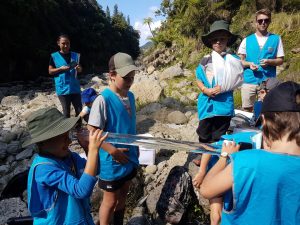 NGAMATAPOURI SCHOOL MONITORS THE WAITOTARA RIVER – this rural school of eight students is doing some amazing things. In this isolated area, flooding by the Waitotara River is a regular hazard that has had devastating impacts on the community in the past. Students are working with scientists and engineers to create their own flood warning devices that will send a signal to the school and local residents to warn them about rising water levels. The students are also doing regular water quality monitoring and mapping the way the river changes over time using a drone.
NGAMATAPOURI SCHOOL MONITORS THE WAITOTARA RIVER – this rural school of eight students is doing some amazing things. In this isolated area, flooding by the Waitotara River is a regular hazard that has had devastating impacts on the community in the past. Students are working with scientists and engineers to create their own flood warning devices that will send a signal to the school and local residents to warn them about rising water levels. The students are also doing regular water quality monitoring and mapping the way the river changes over time using a drone.
- TRASHFORMERS –
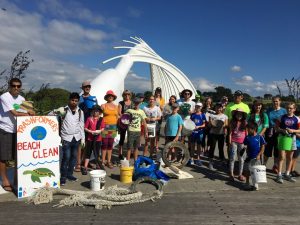 This project is led by Upcycle Taranaki and a team of young people from a variety of schools around New Plymouth. The team are investigating the potential to use recycled plastics collected from beach cleans to make a variety of products including building materials. The students have had to design methods for identifying the degraded plastic; they’ve engineered an extruder machine that melts down and reforms plastic; and they will be carrying out strength testing on the newly formed products.
This project is led by Upcycle Taranaki and a team of young people from a variety of schools around New Plymouth. The team are investigating the potential to use recycled plastics collected from beach cleans to make a variety of products including building materials. The students have had to design methods for identifying the degraded plastic; they’ve engineered an extruder machine that melts down and reforms plastic; and they will be carrying out strength testing on the newly formed products.
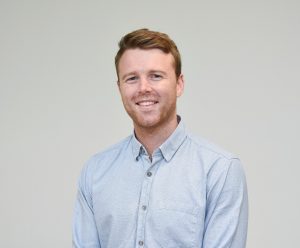 ABOUT JOSH RICHARDSON
ABOUT JOSH RICHARDSON
Josh is the Area Lead for the Participatory Science Platform (PSP) in the Taranaki region of New Zealand. He is passionate about engaging the public in STEM.
“From my own experience, science has opened so many doors and allowed me to explore the world around me. I think, in the past, we (scientists) have done a bad job of highlighting the relevance of science to people’s everyday lives, and because of this many people might think that science, and STEM in general, is beyond their understanding. Engaging people in science and giving them the opportunity to explore a topic that is important to them is a great way of shifting attitudes and increasing confidence in STEM.”
 ABOUT CURIOUS MINDS
ABOUT CURIOUS MINDS
Curious Minds was set up by the government in New Zealand to improve public engagement with science and technology. There are several action areas under the initiative, one of which is the Participatory Science Platform.
ABOUT THE PARTICIPATORY SCIENCE PLATFORM
The Participatory Science Platform (PSP) is a world-first initiative that aims to engage communities of all kinds in research projects that are locally relevant and have robust science/technology outputs with quality learning outcomes. The PSP funds projects aimed at enhancing teaching and learning, engaging communities with science and tech, connecting research with society, and promoting mentoring through an ambassadorship programme.

